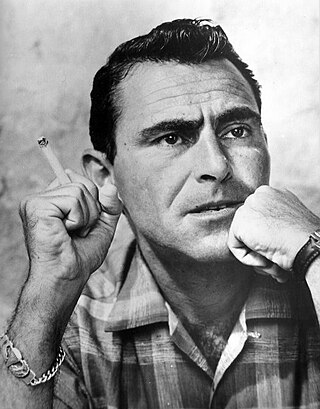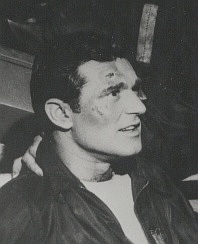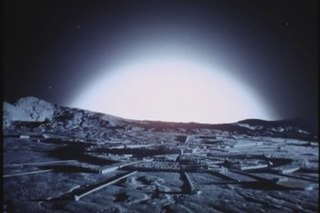Related Research Articles

The Twilight Zone is an American media franchise based on the anthology television series created by Rod Serling in which characters find themselves dealing with often disturbing or unusual events, an experience described as entering "the Twilight Zone". The episodes are in various genres, including fantasy, science fiction, absurdism, dystopian fiction, suspense, horror, supernatural drama, black comedy, and psychological thriller, frequently concluding with a macabre or unexpected twist, and usually with a moral. A popular and critical success, it introduced many Americans to common science fiction and fantasy tropes. The first series, shot entirely in black-and-white, ran on CBS for five seasons from 1959 to 1964.

Rodman Edward Serling was an American screenwriter and television producer best known for his live television dramas of the 1950s and his anthology television series The Twilight Zone. Serling was active in politics, both on and off the screen, and helped form television industry standards. He was known as the "angry young man" of Hollywood, clashing with television executives and sponsors over a wide range of issues, including censorship, racism, and war.

"Where Is Everybody?" is the first episode of the American anthology television series The Twilight Zone and was originally broadcast on 2 October 1959, on CBS. It is one of the most realistic Twilight Zone episodes, as it features no supernatural elements and is based on fairly straightforward extrapolation of science.
"Escape Clause" is episode six of the American television anthology series The Twilight Zone. It is "the story of a strange contract between a mortal man and his most satanic majesty"; it originally aired on November 6, 1959, on CBS.
"I Shot an Arrow into the Air" is the fifteenth episode of the American television anthology series The Twilight Zone.

"The Last Flight" is the eighteenth episode of the American television anthology series The Twilight Zone. Part of the production was filmed on location at Norton Air Force Base in San Bernardino, California. The vintage 1918 Nieuport 28 biplane was both owned and flown by Frank Gifford Tallman, and had previously appeared in many World War I motion pictures.

"People Are Alike All Over" is episode 25 of the American television anthology series The Twilight Zone.
"Eye of the Beholder" is episode 42 of the American television anthology series The Twilight Zone. It originally aired on November 11, 1960, on CBS.
"The Invaders" is episode 15 of season 2 of the American television anthology series The Twilight Zone. The episode, which originally aired January 27, 1961, starred Agnes Moorehead. It was written by Richard Matheson, directed by Douglas Heyes, and scored by Jerry Goldsmith. Distinctive features of this episode include a near-solo performance by one character, and an almost complete lack of dialogue. The only dialogue in the entire episode aside from Rod Serling's usual narration came from Douglas Hayes, the episode's director. In addition, this is the only episode in which Rod Serling gives his opening monologue at the start of the prologue, rather than the end. The protagonist portrayed by Agnes Moorehead often cries out in pain and terror, but never speaks.

"The Obsolete Man" is episode 65 of the American television anthology series The Twilight Zone, starring Burgess Meredith as Romney Wordsworth, the accused, and Fritz Weaver as the Chancellor. It originally aired on June 2, 1961, on CBS. The story was later adapted for The Twilight Zone Radio Dramas starring Jason Alexander as Wordsworth.
"The Midnight Sun" is episode 75 of the American television anthology series The Twilight Zone, first shown in November, 1961.
"The Parallel" is episode 113 of the American television anthology series The Twilight Zone. In this episode an astronaut returns from a voyage to find the world not quite the same as he remembers it. It was an early example of the concept of mirror or alternate universes. The Star Trek: The Original Series episode "Mirror, Mirror" was another example, although the differences between the characters in the two Star Trek alternate universes were quite noticeable. The concept has also been used by both DC Comics and Marvel Comics in their comic books and cinematic universes.
"Probe 7, Over and Out" is an episode of the American television anthology series The Twilight Zone. Its plot is a shaggy God story.
"A Kind of a Stopwatch" is a 1963 episode of the American television anthology series The Twilight Zone. In this episode, a man acquires a stopwatch which can stop time.

The Twilight Zone is an American fantasy science fiction horror anthology television series created and presented by Rod Serling, which ran for five seasons on CBS from October 2, 1959, to June 19, 1964. Each episode presents a standalone story in which characters find themselves dealing with often disturbing or unusual events, an experience described as entering "the Twilight Zone", often with a surprise ending and a moral. Although often considered predominantly science-fiction, the show's paranormal and Kafkaesque events leaned the show much closer to fantasy and horror. The phrase "twilight zone", inspired by the series, is used to describe surreal experiences.

Mary Loretta Hartley is an American film and television actress. She is possibly best known for her roles in film as Elsa Knudsen in Sam Peckinpah's Ride the High Country (1962), Susan Clabon in Alfred Hitchcock's Marnie (1964), and Betty Lloyd in John Sturges' Marooned (1969). She has appeared extensively on television, with notable roles as Claire Morton in the ABC soap opera Peyton Place (1965), various roles in the CBS television western drama series Gunsmoke, and a series of commercials with James Garner in the 1970s and 1980s.
"The Little People" is episode 93 of the American television anthology series The Twilight Zone. It originally aired on March 30, 1962 on CBS.

"Breakaway" is the first episode of the first series of Space: 1999. The screenplay was written by George Bellak ; the director was Lee H. Katzin. Previous titles include "Zero-G", "The Void Ahead" and "Turning Point". The final shooting script is dated 22 November 1973. Live-action filming took place from Monday 3 December 1973 to Friday 11 January 1974. A three-day re-mount took place Friday 22 February 1974 to Tuesday 26 February 1974.
"Cavender Is Coming" is episode 101 of the American television anthology series The Twilight Zone. It originally aired on May 25, 1962 on CBS.
Suspended animation in fiction refers to the temporary cessation of life processes experienced by fictional characters, followed by their subsequent revival. This process is commonly employed as a plot device in science fiction narratives. It is frequently utilized to transport a character from the past to the future or to facilitate interstellar space travel, which necessitates an extended journey for months or years. In addition to accomplishing the character's primary objective in the future, they often encounter the unfamiliarity of a new world, which may bear only faint resemblance to their previous surroundings. On occasion, a character is portrayed as possessing skills or abilities that have become lost to society during their period of suspension, enabling them to assume a heroic role in their new temporal setting.
References
- DeVoe, Bill. (2008). Trivia from The Twilight Zone. Albany, GA: Bear Manor Media. ISBN 978-1-59393-136-0
- Grams, Martin. (2008). The Twilight Zone: Unlocking the Door to a Television Classic. Churchville, MD: OTR Publishing. ISBN 978-0-9703310-9-0